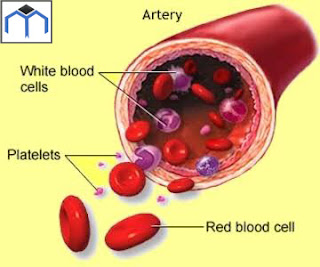The red fluid flowing in our body is known as blood. This red fluid is responsible for transportation of Oxygen, carbon dioxide, nutrients and hormones to every body parts and vice-versa. It also plays a major role in messenger system of human body and brain due to dissolved ions in the blood. Blood also regulate the average body temperature of human beings.
Some Facts on Blood
There are three parts of Blood Corpuscles :-
Blood clotting is the process of coagulation of blood after wounds and cuts through complex chemical reactions which happens in three steps given below :-
[/lock]
Some Facts on Blood
- The quantity of blood in human body is around 6-7%.
- The pH of blood is around 7.4.
- Blood can be divided in two parts :- (A) Plasma. (B) Blood Corpuscles
- Plasma is about 60% of the total blood and around 90% of it is water.
- Plasma contains protein(7%), salts(1%) and glucose(0.1%).
- Plasma transports hormonal chemicals, digested food and excretory products from one part to another part of our body.
- The Fibrinogen and Prothrombin are essential chemicals to clot the blood are actually present in plasma. Without this Fibrinogen and other proteins the plasma is known as serum.
 |
| Blood Corpuscles |
There are three parts of Blood Corpuscles :-
- Red Blood Corpuscles (RBC)
- White Blood Corpuscles (WBC)
- Blood
- Red Blood Corpuscles is red due to presence of iron(Fe) based compound called Hemoglobin in Heme is iron complex while globin is a protein.
- RBC is formed in bone marrow of humans body and its life span is around 20 days to 120 days.
- One of the most important fact about plasma is it lacks nucleus in it. There are two exceptions of this is Camel and Lama, whose RBCs has nucleus into it.
- The main function of RBC is to carry the oxygen from the lung to all cells of the body and brings carbon dioxide from all body parts to lung, because hemoglobin has exceptional tendency to combine with oxygen and carbon dioxide.
- Hemocytometer is used to measure the RBC count of the blood.
- The destruction of RBC happens in lever and spleen and life span of RBC is from 20 days to 120 days.
- WBC has nucleus present in it and its life span is around 2-4 days.
- One of the main function of White Blood Corpuscles in our body is to protect it from external agents which cause diseases.
- WBC is formed in Bone marrow, live, lymph nodes and spleen.
- The ratio of RBC to WBC is 600 : 1.
- It's formation also takes place in bone marrow with life span of 3 - 5 days and finally dies in the spleen.
- One of the primary and most important function of blood platelets are in clotting of blood.
- Blood platelets are only found in the body of mammals.
Blood clotting is the process of coagulation of blood after wounds and cuts through complex chemical reactions which happens in three steps given below :-
- Thromboplastin + Prothrombin + Calcium = Thrombin.
- Thrombin + Fibrinogen = Fibrin.
- Fibrin + Blood Corpuscles = Clot.
If you want to download "Human Blood : Components and their Functions" in PDF Format please like or share our post below to unlock the PDF.
[lock] [/lock]